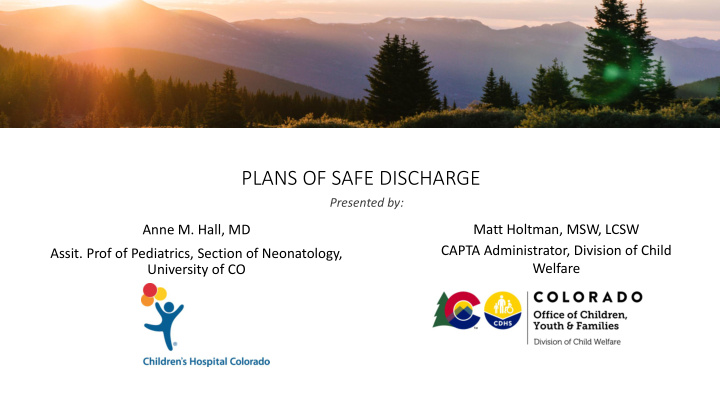



PLANS OF SAFE DISCHARGE Presented by: Matt Holtman, MSW, LCSW Anne M. Hall, MD CAPTA Administrator, Division of Child Assit. Prof of Pediatrics, Section of Neonatology, Welfare University of CO
SAFE DISCHARGE OF THE SUBSTANCE EXPOSED NEWBORN • Infants exposed to substances in utero are at high risk o increased risk attachment disorders o neurodevelopmental and behavioral issues o safety concerns due to drug seeking behaviors • Discharge of any infant exposed to substances, prescribed or illicit, should include careful planning and involvement of a multidisciplinary team.
SAFE DISCHARGE OF THE SUBSTANCE EXPOSED NEWBORN Timing for discharge • Physiologic maturity of the infant • Resolution of medical issues • Appropriate discharge planning and follow-up have been completed • Parent/Caregivers have received all necessary education and training
CHILD ABUSE PREVENTION AND TREATMENT ACT (CAPTA) • Key federal legislation addressing child abuse and neglect • Recent amendment 2016 – Comprehensive Addiction and Recovery Act
SAFE DISCHARGE OF THE SUBSTANCE EXPOSED NEWBORN • Development of Discharge Guidelines to meet CAPTA goals • Adapted from the 2008 AAP Guidelines from the Committee on Fetus and Newborn regarding the Hospital Discharge of the High-Risk Neonate • SEN-specific language for hospital Discharge Summary
DISCHARGE PLANNING Development of comprehensive home-care plan should be completed prior to discharge by a multidisciplinary group
DISCHARGE PLANNING… • Components of a home-care plan should include: o Identification of in-home care givers o Formulation of a plan for nutritional and medical care o Development of a list of required supplies if applicable o Identification of primary care physician (PCP for infants and caregivers)
DISCHARGE PLANNING… • ...Components of a home-care plan should include: o Identification of community resources/treatment programs for caregivers o Assessment of the home environment o Development of emergency care and transport plan o Assessment of financial resources
ARRANGEMENTS FOR FOLLOW-UP • Verbal communication with the PCP prior to discharge • Neurodevelopmental follow-up or Early Intervention Referral • Follow-up for the caregiver should be identified and arranged prior to discharge o Follow-up with PCP o Follow-up with Social worker/case worker after discharge o Follow-up with treatment program and/or counselor if applicable o Visiting home nurse if available
PARENT/CAREGIVER EDUCATION • Parents/caregiver must be present during hospitalization and display competency in cares of the infant prior to discharge. o When possible at least 2 caregivers should be identified • Parents/caregiver must exhibit readiness to assume full responsibility for the infant’s care after discharge. o Development of an individualized teaching plan o Consider creating checklist or outline of tasks
BENEFITS TO THE FAMILY The Plan of Safe Care information may be used to assist with screening decisions. It may help with locating safe natural supports for the family and prevent unnecessary removals. It may provide information of potential caregivers if placement is required.
BENEFITS TO THE FAMILY This is a portable plan which ensures all systems are speaking the same language. Discharging hospital, mother and baby’s PCP, child welfare, treatment facility or provider all sharing one plan. Helps to ensure a focused intervention and accountability for everyone.
NEXT STEPS • Disseminate statewide to hospitals caring for SEN • Disseminate statewide to child welfare departments
CONTACT INFORMATION Matt Holtman, MSW, LCSW Anne M. Hall MD Anne.Hall@childrenscolorado.org Matt.Holtman@state.co.us 303-257-3906 303-866-4897
Recommend
More recommend